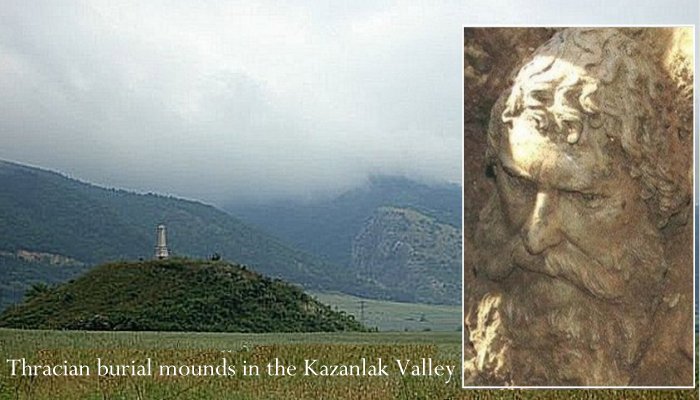Remarkable Thracian Tomb In Huge Mound Necropolis Of Kazanlak, Bulgaria
A. Sutherland - AncientPages.com - The 'Valley of Thracian Kings' is an extraordinary place with numerous burial mounds (tumuli) containing the Thracian rulers' and high aristocrats' tombs and graves.
The tumuli are located in the valley of the Central Bulgarian town of Kazanlak, excavated by the late Bulgarian archaeologist Georgi Kitov, specializing in Ancient Thrace, who excavated most of the tombs in the Kazanlak Valley and named it the Valley of the Thracian Kings.
More than a thousand burials of kings and members of the Thracian aristocracy have their location in the valley. Thracian Tomb of Kazanlak - accidentally discovered in 1944 - dates from the Hellenistic period, around the end of the 4th century BC, and is part of a large Thracian necropolis.
The architectural structure known as the 'tholos' features a narrow passageway leading to a circular burial chamber adorned with intricate murals depicting the funerary rituals and cultural traditions of the Thracian civilization.
These artistic representations provide a profound insight into the ceremonial practices and belief systems integral to this ancient society.
Mural of the Chariot race with border detail in the burial chamber in a replica of the Thracian tomb of Kazanlak (dated to the 4th century BC) in the central Bulgarian town of Kazanlak. Image contributor: Psy guy - CC BY-SA 3.0
The royal necropolis is located near Seuthopolis (Seutopolis), the capital city of the Thracian king Seutes III. Established in 323 B.C. by the Thracian ruler Sevt III, the city became a prominent political, economic, and cultural hub within the Kazanlak region.
The ancient Seuthopolis contained numerous architectural marvels, including the palace-temple complex, the temple dedicated to Dionis, and the Temple of the Great Thracian Deities. These towers stood as a testament to this ancient city's grandeur and cultural significance.
The strategic geographical positioning helped Seuthopolis become the capital of the state of Sevt, a position it retained until 270 B.C. Unlike the Valley of the Kings in Egypt, the Valley of the Thracian Kings is where the Thracian rulers and high aristocrats were buried.
The ancient Thracians were an ethno-cultural group of Indo-European tribes that inhabited much of Southeast Europe (modern-day Bulgaria, Romania, Moldova, Greece, Turkey, Macedonia, Serbia) from about the middle of the second millennium BC to about the 6th century AD.
Thracian Tomb (probably of Thracian king), at Kazanlak, Bulgaria. It's one of the best-preserved in Bulgaria. Image contributor: Psy guy - CC BY-SA 3.0
The Thracians built artificial mounds around their funeral structures; they believed that when the king ended his journey in this world, he must return to his mother's womb. The kings were considered sons of the great goddess Mother Earth, and the burial rites were highly symbolic.
The paintings in the tomb represent Bulgaria's best-preserved artistic masterpieces from the Hellenistic period. The Thracians were skilled goldsmiths and possessed advanced knowledge of metalworking and horsemanship.
However, as far as is known, they did not have a written tradition and left no written records.
Thracians believed in the afterlife and the immortality of the soul. By these beliefs, the funerary practices involved interring deceased rulers alongside their possessions, including horses, dogs, weapons, drinking vessels, and even gaming implements such as dice. This practice was rooted in the notion that these items would accompany the departed on their journey into the realm beyond mortal existence.
Originally posted to Flickr as National Archaeological Museum Sofia - Golden Funeral Mask from the Svetitsata Tumulus (King Teres?). Image credit: Ann Wuyts - CC BY 2.0
The golden funerary mask (above) was among the items discovered in a grave in 2004 during archaeological excavations on the Svetitsata mound near the village of Kran in the Stara Zagora region.
A noble Thracian man, aged about forty, was buried in the grave. According to a local burial rite - usually associated with the Orphism - his body had been dismembered, the grave receiving only fragments from the skull and his legs.
The golden mask weighs 673 grams and images the face of an adult man, with clearly portrayed individual features.
It was cast and additionally processed by forging and chiseling. The portrait is dated to the 5th century BC and is the only mask of this kind from this period in Thrace and the Mediterranean area. It said it was the mask of the Odrysian King Teres.
The tumuli in the Thracian valley contain treasures and a variety of exquisite burial monuments.
Built from huge granite blocks or bricks, they consist of a corridor and one or more chambers, each revealing its own meticulous design and beautiful ornamentation.
There are many tombs, but no two tombs are alike. Inside, a slim column helps support the vaulted ceiling of the burial chamber, the walls of which are adorned by seven half-columns.
Fresco from the thracian tomb of Kazanlak, Bulgaria. Image credit: Kmrakmra - CC BY-SA 3.0
The Ostrusha tumulus nearby contained a sarcophagus-like chamber hewn from a single granite block thought to have weighed 60 tonnes.
The traces of civilized life indicate that the Thracians continued many of the traditions of the prehistoric people who inhabited the region in today's Central Bulgaria. One of the most beautiful monuments of the Thracian civilization in the Valley of the Thracian Kings is the temple-tomb of Seuthes III, probably the wealthiest Thracian king's tomb, dating back to the 5th century BC.
Seuthes III was the ruler of the Odrysian kingdom of Thrace from c. 331 BC to c. 300 BC. He moved the Odrysian Kingdom - with more than 40 Thracian tribes and 22 kingdoms - to central Thrace and built his capital city at Seuthopolis (Kazanlak), present-day Bulgaria.
His tomb is located near the Bulgarian town of Shipka, Kazanlak municipality. The temple was buried under the 20-meter (66 ft) high "Golyamata Kosmatka" mound.
Written by – A. Sutherland - AncientPages.com Senior Staff Writer
Copyright © AncientPages.com All rights reserved. This material may not be published, broadcast, rewritten or redistributed in whole or part without the express written permission of AncientPages.com
Expand for referencesMore From Ancient Pages
-
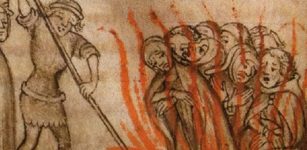 On This Day In History: Knights Templar Arrested – Oct 13, 1307
News | Oct 13, 2015
On This Day In History: Knights Templar Arrested – Oct 13, 1307
News | Oct 13, 2015 -
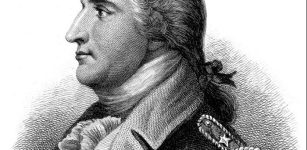 On This Day In History: American General Benedict Arnold Commits Treason – On Sep 21, 1780
News | Sep 21, 2016
On This Day In History: American General Benedict Arnold Commits Treason – On Sep 21, 1780
News | Sep 21, 2016 -
 Altai Mountains Were Home To Porcupines 30,000 Years Ago
Archaeology | Mar 14, 2017
Altai Mountains Were Home To Porcupines 30,000 Years Ago
Archaeology | Mar 14, 2017 -
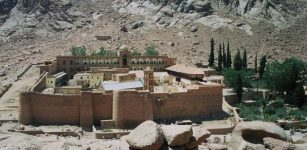 Ancient Scriptures With Lost Languages Discovered Inside Saint Catherine’s Monastery On The Sinai Peninsula
Archaeology | Aug 29, 2017
Ancient Scriptures With Lost Languages Discovered Inside Saint Catherine’s Monastery On The Sinai Peninsula
Archaeology | Aug 29, 2017 -
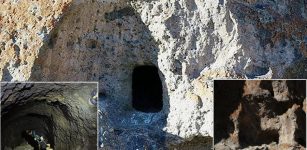 Ancient Urartu Settlement, Water Tunnel And Rock Tombs Found In Erzurum, Eastern Turkey
Archaeology | Dec 19, 2017
Ancient Urartu Settlement, Water Tunnel And Rock Tombs Found In Erzurum, Eastern Turkey
Archaeology | Dec 19, 2017 -
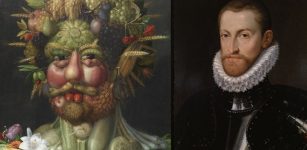 Rudolf II: Eccentric Holy Roman Emperor Whose Occult Interest And Mistakes Led To The Thirty Years’ War
Featured Stories | Apr 9, 2021
Rudolf II: Eccentric Holy Roman Emperor Whose Occult Interest And Mistakes Led To The Thirty Years’ War
Featured Stories | Apr 9, 2021 -
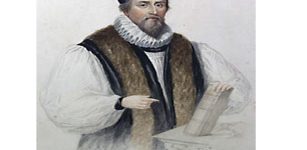 On This Day In History: Bishop of Gloucester John Hooper is Burned At The Stake For Heresy- On Feb 9, 1654
News | Feb 9, 2017
On This Day In History: Bishop of Gloucester John Hooper is Burned At The Stake For Heresy- On Feb 9, 1654
News | Feb 9, 2017 -
 Smallest Arm Bone In Human Fossil Record Illuminates Homo Floresiensis Origin
Archaeology | Aug 7, 2024
Smallest Arm Bone In Human Fossil Record Illuminates Homo Floresiensis Origin
Archaeology | Aug 7, 2024 -
 Secret Archaeological Excavations Have Led To The Discovery Of An Extremely Rare Ancient Roman Gold Treasure In Parc Hosingen, Luxembourg
Archaeology | Jan 20, 2025
Secret Archaeological Excavations Have Led To The Discovery Of An Extremely Rare Ancient Roman Gold Treasure In Parc Hosingen, Luxembourg
Archaeology | Jan 20, 2025 -
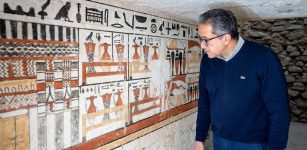 Five Magnificent Engraved Ancient Tombs Discovered Near King Merenre Pyramid In Saqqara, Egypt
Archaeology | Mar 19, 2022
Five Magnificent Engraved Ancient Tombs Discovered Near King Merenre Pyramid In Saqqara, Egypt
Archaeology | Mar 19, 2022 -
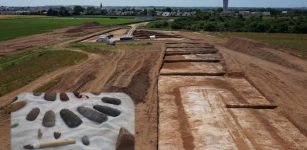 Ancient DNA Unravels The Mystery Of Huge 6,500-Year-Old Cemetery And The Tomb Of A ‘Masculine Woman’ In Normandy, France
Archaeology | May 5, 2022
Ancient DNA Unravels The Mystery Of Huge 6,500-Year-Old Cemetery And The Tomb Of A ‘Masculine Woman’ In Normandy, France
Archaeology | May 5, 2022 -
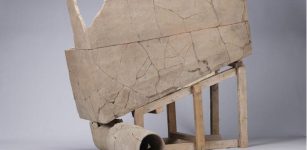 2,400-Year-Old Flush Toilet Discovered In China
Archaeology | Feb 24, 2023
2,400-Year-Old Flush Toilet Discovered In China
Archaeology | Feb 24, 2023 -
 AI Discovers Hundreds Of Unusual Nazca Geoglyphs In The Desert
Places | Oct 7, 2024
AI Discovers Hundreds Of Unusual Nazca Geoglyphs In The Desert
Places | Oct 7, 2024 -
 Stikini ‘Man-Owl’ – Sinister Vampiric Monster That Works In Disguise
Featured Stories | Jan 29, 2019
Stikini ‘Man-Owl’ – Sinister Vampiric Monster That Works In Disguise
Featured Stories | Jan 29, 2019 -
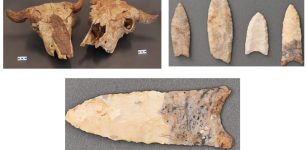 Digesta: An Overlooked Source Of Ice Age Carbs
Archaeology | Apr 24, 2023
Digesta: An Overlooked Source Of Ice Age Carbs
Archaeology | Apr 24, 2023 -
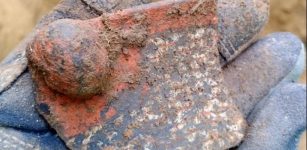 6,000-Year-Old Discovery Of Artifacts Associated With Ancient Lengyel Culture
Archaeology | Mar 27, 2020
6,000-Year-Old Discovery Of Artifacts Associated With Ancient Lengyel Culture
Archaeology | Mar 27, 2020 -
 Scientists Say Large Mammals Shaped The Evolution Of Humans – Here Is What Happened
Featured Stories | Jan 27, 2023
Scientists Say Large Mammals Shaped The Evolution Of Humans – Here Is What Happened
Featured Stories | Jan 27, 2023 -
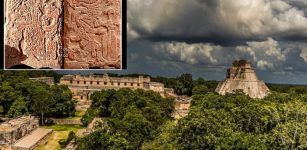 Ancient Maya Stela Carved On Both Sides Unearthed ‘In Situ’ In Uxmal, Yucatan Peninsula
Archaeology | Oct 31, 2022
Ancient Maya Stela Carved On Both Sides Unearthed ‘In Situ’ In Uxmal, Yucatan Peninsula
Archaeology | Oct 31, 2022 -
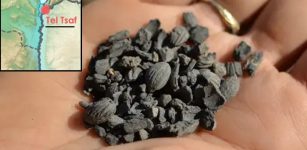 Ancient Cotton Fibers Dating Back 7,000 Years Discovered In NE Israel
Archaeology | Dec 19, 2022
Ancient Cotton Fibers Dating Back 7,000 Years Discovered In NE Israel
Archaeology | Dec 19, 2022 -
 Underwater Archaeologists Retrieve Over 100 Magnificent Glass Objects at Chengene Skele Bay, Bulgaria
Archaeology | Jul 16, 2024
Underwater Archaeologists Retrieve Over 100 Magnificent Glass Objects at Chengene Skele Bay, Bulgaria
Archaeology | Jul 16, 2024





